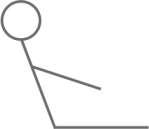Rowing drills can help rowers
- learn something new,
- perfect an aspect of technique, and or
- correct a fault.
Use drills during the warm up, for a few minutes during practice, or for the entire practice. Be sure to spend enough time on the drill to reap its benefits and followup with regular rowing to implement the lessons learned from the drill.
Square blade rowing
Rowing with a square blade can help rowers work on a clean, powerful finish because rowers have to release the blade on the square and cannot cheat by feathering in the water. Rowers can focus on a quick catch without having to square the blade first. Finally, rowers can find and row with a handle height that keeps the blade at an optimal height off the water.
How to:
- Row without feathering the blade; keep the blade perpendicular to the water, or square, during all phases of the stroke.
- Focus on the points above.
Low stroke rate rowing
Rowing with a low stroke rate gives rowers time to feel their body position and movement at each phase of the stroke and is especially effective for working on rhythm and ratio.
How to:
- Row at 20 strokes per minute or less.
- Row each stroke absolutely true, with no pauses or jerks. Try to feel completely relaxed but in full control and balanced.
- Be aware of flow from finish/release, to recovery, to catch, to drive.
- Be aware of how your body feels in each position and adjust as needed.
Balance and hand levels drill (stationary)
Releasing and burying the blades may upset boat balance if rowers’ movements are out of sync and if they have different hand levels. This drill helps all six rowers have the same hand levels when the blade is in the water and when the blade is out of the water.
How to:
- With rowers sitting in various stroke positions – catch, mid stroke, finish – tap the handle down to release the blade from the water and unweigh to drop them back in. Repeat.
- Rowers will need to make adjustments until everyone’s hands are at the same level when the blade is out of the water and when it is in the water.
- The boat should be completely balanced during the entire drill.
Pick drill
Purpose: to isolate aspects of the stroke and to help prepare the upper body for the drive and finish. Transition through each part of the recovery, building each part onto the next.
- Start in the finish position with the blades squared and buried
- The coxswain will call “arms only, ready, row;” row for 10 to 15 strokes with the arms only. With two strokes remaining,
- The coxswain will call, “add the body in two, one, two, on this one;” row for 10 to 15 strokes with the arms and body only. With two strokes remaining,
- The coxswain will call “half slide in two, one, two, on this one;” row for 10 to 15 strokes at half slide. With two strokes remaining,
- The coxswain will call “full slide in two, one, two, on this one;” row for 10 to 15 strokes at full slide.
Example of the pick drill used as a warmup for an erg workout
Catch placement drill
Purpose: to work on body control, blade control, and timing.
How to:
- Part I: Start in the finish position with the blade buried. On ‘row,’ tap out and drop in. Repeat until the timing is perfect.
- Part II: Start as above. On ‘row,’ tap out, recover to the catch position, and place the blades in together. Return to the finish position and repeat until catch timing is perfect.
- Part III: As above but after the catch placement, take a stroke. Finish with arms away, blades down, check it down.
- Be aware of hand heights – hands may raise slightly as the rowers approach the catch but they should never drop.
Reverse pick drill
Purpose: to isolate aspects of the drive and to practice the drive sequence and coordination/timing of movements.
- Start in the catch position with the blades squared and fully buried
- The coxswain will call “legs only, ready, row;” row for 10 to 15 strokes with the legs only (you may start by pushing for 3-4 inches at first, progressing to a full slide push) – no back swing, no arm draw/pull – the shoulders remain in front of the hips and the arms remain extended.
- Call, “add the back swing in two, one, two, on this one;” row for 10 to 15 strokes with legs and back only. With two strokes remaining…
- Call “add the arms in two, one, two, on this one;” row full strokes with legs, back, and arms.
Example of the reverse pick drill on the water
NOTE: the rowing may not look perfect when you are doing a drill such as this one. That is fine as long as you are working hard to execute well and perfect your technique.
Pairs and fours rowing
Rowing in pairs or fours gives rowers a chance to row in a balanced boat as the rowers that are not rowing can balance the boat. Rowers can concentrate on their own stroke and can feel the connection with the water.
How to:
There are many ways to row in pairs and fours. This is one way.
- Start with the stern pair (5 and 6) and let them row 10 + strokes together
- Call in the next pair and row all four together for a couple of strokes.
- Call in the last pair and row all six together for a minute or more.
- Drop off two pairs and start again (with a different pair starting this time).
- Continue in this manner for as long as needed.
Pause drills
Pause at the release

Purpose: to assess body angle, posture and outside arm position at the release. Feedback and adjustments can be made as needed.
Watch for the outside hand tapping down with a flat wrist, shoulders are low and relaxed, the back is straight and tall. The rower is relaxed – no tension.
- Finish the stroke sitting tall with the handle all the way into the body.
- Pause in this position and tap the handle down with the outside hand to get the blade out of the water clean and on the square – do not feather. The outside wrist should be flat.
- After a slight pause move the arms away together to the next pause position or, finish the stroke.
Pause at arms away

Purpose: to work on timing at the release and a smooth, unrushed movement of the hands away.
Watch for the hands moving away together, at the same height. Shoulders should be relaxed and the shoulders and back remain stable as the hands move away from the body.
- Row without pausing for a few strokes to get the boat moving
- The coxswains will call “pause on this one”
- Release of the blade from the water, keeping the body in the lay back position and the legs flat
- Push the hands away smoothly, feeling the run of the boat, and pause when the arms are fully extended.
- On the coxswains call to row, pivot from the hips and slide forward, and complete the stroke. Do not change your hand levels as you move forward or at the catch.
Pause at body over

Purpose: to help rowers establish the forward body angle early in the recovery so that they can move to the catch position without lunging for more length at the catch.
Notice from the images that the body angle does not change after the body angle is set. Watch the upper body after the pause to ensure that the angle does not change after the knees bend. Watch also to ensure that rowers do not “rush the slide” going into the catch.
- Row without pausing for a few strokes to get the boat moving
- The coxswains will call “pause on this one”
- Release of the blade from the water, keep the body steady and move the hands away, smooth and gentle.
- When the arms are almost fully extend, start to rock your body over from your hips, while completing your arm extension, to set your body angle
- Pause when the body is forward, in the 1:00 position – your arms should be fully extended and your upper body angled forward.
- On the coxswains call to “row,” slide forward, come up to the catch, drop the blade in, and execute the drive, pausing at body forward.
Feet out
When you lose contact with the footboard, you stop moving the boat and you will likely have a weak finish.
Rowing with your feet in the straps allows you to lose contact with the footboard as the straps keep you from falling off the seat.
Rowing with your feet out of the straps requires that you use your body to keep contact with the seat and it will provide feedback on how far you should lay back. If you lay back too far you will fall off the seat. Rowing with your feet out helps you to activate and develop your glutes and core muscles as you will to need to engage these muscles to maintain pressure on the footboard and to keep yourself from falling back.
How to:
- Unstrap your feet and start to row
- Focus on your drive sequence and having your legs, back and arms finish at the same time
- Focus on using your core and your breathing to increase your stability and to keep your feet on the footplate
- Be sure to row long, true strokes
Cut the cake
This drill helps with body control while in the finish position, coordination of movements with other rowers, and blade control.
In this how to, you will complete one actual stroke and you will cut the cake in the middle of that stroke:
- Stroke 1, part 1: start in the catch position, drive through to the finish and, on the recovery, cut the cake (this is an air stroke – the blade does not enter the water)
- move the hands away, swing the body forward, then swing back and draw the arms in
- Stroke 1, part 2: move the hands away, swing the body forward, slide up for the next stroke